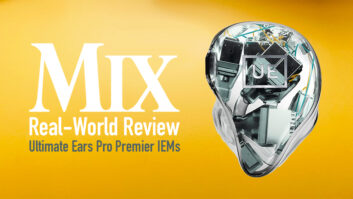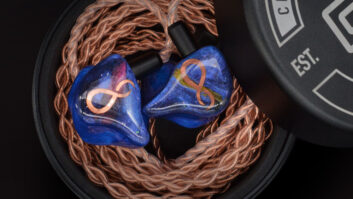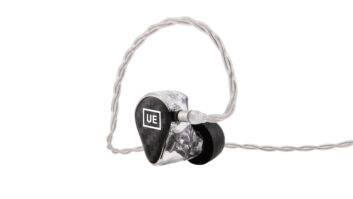For years I have regretted my pierced tragus. The tragus is that little flap of skin that covers the opening in to your ear canal. The actual piercing is remarkably painless (not a lot of nerve endings there).
Trying to fit in-ear monitors or earbud-type headphones around the ring? Impossible – and very painful. An earbud never stays in place for long so I can either jam it back in place every few seconds, live with over-ear headphone sweat (yum), or accept the poor stereo imaging from having one headphone further away from my ear than the other.

Then, it happened. On an otherwise ordinary day at Prolight + Sound, Frankfurt, some benevolent (and body-modification sympathetic) deity guided me to the Ultimate Ears booth.
There was magic happening there. Sorcerers were waving powerful wands inside people’s ears, capturing exact 3D models of every fold of skin and precise measurements of ear canals.
“Can you work around this?” I ask Ultimate Ears Pro Sales Director Mike Dias, pointing to the captive bead ring through my tragus. Within minutes both he and Craig Jones, chief operating officer at United Sciences are staring at my ear.
I’m surprised this isn’t something they’ve had to do before, but grateful they’ve decided to accept the challenge. I sat in front of the scanner, fishing line holding my ring in what is deemed the optimal position for success while Jones takes the required measurements.

A few weeks later, my Ultimate Ears arrive. I start with my non-pierced left ear and it fits beautifully. Now comes the moment of truth. I fiddle with my ring to get it roughly in the same position as it was during the scans, twist my monitor into my ear and…
Success. Glorious, glorious success!
I give my head a shake; not because I have a hard time believing I’ve found a monitor I can comfortably wear but because I want to make sure it’s not going to fly out of my ear like every other earbud does. It stays put. Amazing!

A full hour of listening later and both monitors are sitting in the same position, and very comfortably. More importantly, there is no longer a 3+ dB disparity between my left and right ears.
I’m sure one day I’ll get fed up with my piercing and take it out for good. For now, I can safely say that I’ve found a piercing-friendly headphone solution, and that makes my ears happy.
The Listening Experience
Having (finally) found a listening solution that was physically comfortable, it was time to put the monitors through a proper listening test.
Casual portable listening: While it may seem counter-intuitive to plug in a pair of high-quality monitors into your smartphone to listen to MP3s, there are advantages to doing so. Playback levels can be turned right down on public transportation as the custom fit provides excellent isolation from noise without introducing any digital signal processing artifacts common in noise-cancelling headphones (A word of caution: isolation is great on a subway, mildly terrifying when crossing a busy intersection. Look both ways, people). The UE studio reference monitors (model RM) offer a very neutral listening experience which makes most MP3s sounds a bit flat compared to consumer-grade, bass heavy headphones. It’s still a far superior listening experience to your typical ear bud, and you won’t annoy anyone with the tinny sound of a hi-hat, either.
Connoisseur listening: Even my best over-ear headphones failed to reveal the minute details of Tom Waits’ Heartattack and Vine that I could hear using the Ultimate Ears monitors. A little cough here, the rumble of something (probably a truck) there, even some nose breathing. Listening to FLAC files through VLC on my computer, I could hear the full length of the delicate reverb used on Waits’ vocals. “Big John” Thomassie’s drums sound positively gorgeous and most importantly, dynamic. Having access to these fine details has the effect of putting you in the control room as it’s being recorded, if not right in with the artists. Headphones may not be the preferred listening method for most audiophiles, but the extra intimacy of having the music piped directly into your ear is definitely worth giving it a shot.
Critical Listening: For this test I thought I’d switch gears and fire up some dance-y Ableton sessions. It was a humbling experience, to say the least. I’m fortunate for my very polite friends, but the Ultimate Ears reference monitors do not tolerate poor mixes kindly. What they do afford is an honest foundation to mix on, and it didn’t take very long to identify and rectify some nasty distortion in the low end. You won’t ever hear that satisfying (but artificial) chest-thumping bass through UE’s studio reference monitors, but they will force you to eke out the biggest thump you can and it will sound enormous on consumer headphones. Trust me.
Conclusion
I want three things from my monitors: comfort, honesty and accuracy. Ultimate Ears ticks all those boxes. If I could change one thing, I’d make the cable longer, but that is my only real complaint [longer cables and cable sets with in-line mics for phone use can be specified when ordering UE earsets—ED]. The world is getting noisier and jobs are increasingly more mobile. To be able to deliver all the above, while blocking out environmental sound – and accommodating modern body piercings – makes Ultimate Ears a very worthwhile investment.
Ultimate Ears Professional • pro.ultimateears.com
Related Stories
Pro Audio Review cover story on Ultimate Ears reference monitors
A photo tour of the process of both standard and 3D printed ear molds at the UE factory
UE’s transition to 3D printing
PSN editor in chief Frank Wells explored digital ear scanning in his March, 2014 editorial (“Last year, we covered Ultimate Ears’ move to 3D printing of custom ear molds, hinting at direct laser scans of the inner ear that would preclude the need for taking silicone ear impressions. The future is here. See staffer Steve Harvey’s ear being taken in realtime at https://www.youtube.com/watch?v=ZgvcGIKuleA. This is a game changer. No audiologist is required; an hourly employee can be trained to make the scans. Coupled with UE’s product selector app, now ported to the iPad, the stage is set for retail level sales of fully custom IEM products.”)




